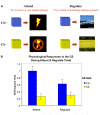Neural circuitry underlying the regulation of conditioned fear and its relation to extinction
- PMID: 18786365
- PMCID: PMC3061554
- DOI: 10.1016/j.neuron.2008.06.029
Neural circuitry underlying the regulation of conditioned fear and its relation to extinction
Abstract
Recent efforts to translate basic research to the treatment of clinical disorders have led to a growing interest in exploring mechanisms for diminishing fear. This research has emphasized two approaches: extinction of conditioned fear, examined across species; and cognitive emotion regulation, unique to humans. Here, we sought to examine the similarities and differences in the neural mechanisms underlying these two paradigms for diminishing fear. Using an emotion regulation strategy, we examine the neural mechanisms of regulating conditioned fear using fMRI and compare the resulting activation pattern with that observed during classic extinction. Our results suggest that the lateral PFC regions engaged by cognitive emotion regulation strategies may influence the amygdala, diminishing fear through similar vmPFC connections that are thought to inhibit the amygdala during extinction. These findings further suggest that humans may have developed complex cognition that can aid in regulating emotional responses while utilizing phylogenetically shared mechanisms of extinction.
Figures






References
-
- Amaral DG. The primate amygdala and the neurobiology of social behavior: implications for understanding social anxiety. Biol. Psychiatry. 2002;51:11–17. - PubMed
-
- Barbas H. Connections underlying the synthesis of cognition, memory, and emotion in primate prefrontal cortices. Brain Res. Bull. 2000;52:319–330. - PubMed
-
- Beck AT, Emery G, Greenberg RL. Anxiety Disorders and Phobias: A Cognitive Perspective. 15th Anniversary Edition Basic Books; Cambridge, MA: 2005.
-
- Buchel C, Dolan RJ. Classical fear conditioning in functional neuroimaging. Curr. Opin. Neurobiol. 2000;10:219–223. - PubMed
Publication types
MeSH terms
Substances
Grants and funding
LinkOut - more resources
Full Text Sources
Other Literature Sources
Miscellaneous

